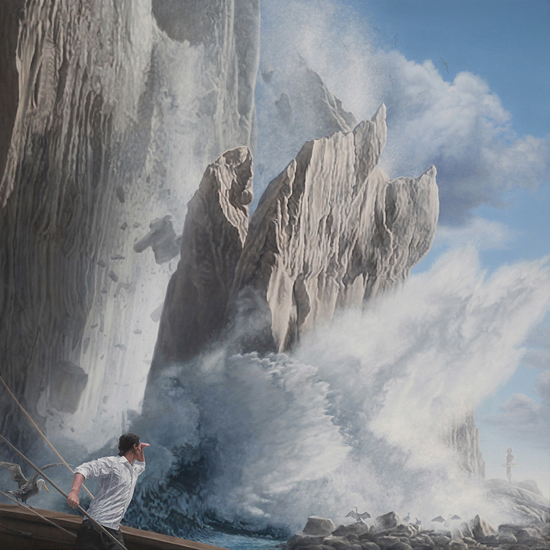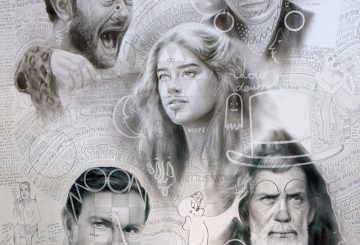Guest blogger Jane Denison is hooked on the wide open vistas of Joel Rea‘s sublime surrealism…
Joel Rea paints epic-like visual fantasies in his new work at Metro Gallery in Melbourne. Intrigued by chance, duality and alternate possibilities, Rea’s hyperrealist paintings delve into the depths of our minds. Using the physical elements as a metaphor for human emotion and experience, Rea portrays nature as pulsating energy that is both majestic and threatening. Recurring motifs include waves smashing upon craggy outcrops of rocks and immense skies filled with dark explosive clouds. In these dynamic scenarios, Rea places figures (mainly of the artist and his wife) as a ploy for the narrative. One of the strongest pieces in the exhibition depicts a suited Rea in mid flight propelling into an expanse of sky. With outstretched arms and head flung back, the title Liberation suggests the euphoria associated with release from the shackles of everyday responsibility. Yet things are never straightforward in Rea’s world. Brewing storm clouds behind the figure suggest tumult, and we can’t be sure whether the figure is ascending or descending into a void. In producing work that raises questions, Rea hesitates offering definitive meanings preferring to leave interpretation to the prerogative of the individual viewer. ‘As well as striving to produce aesthetically beautiful images, I try to manipulate the kaleidoscope where one person views the image as negative and dark and another person sees it as positive and uplifting.’
Joel Rea, Collision 2013. Oil on canvas, 122x122cm.
Another Time, Another Place is Rea’s first appearance at Metro Gallery. Born in 1983 and raised on the Gold Coast, Rea is gaining recognition as an artist to watch. Since graduating from Queensland Collage of Art in 2003, Rea has been regularly selected as a finalist in national art awards and was listed in last month’s American Art Business News as one of 30 international young artists changing the art world. Rea’s path to becoming an artist hasn’t been easy, and his new work maps his deepest fears and experiences. In viewing his experiences as inextricably linked to others, Rea explains: ‘my paintings reveal our similarities as human beings, and at the same time our dense complexity and individuality.’
Rea describes himself as a Contemporary Surrealist Painter, but his work is also a twist on the aesthetics of the sublime in 18th century Romantic art. In common with Romantic artists, Rea is interested in the duality of opposites where nature is a source of purity and timelessness while also a dark sentiment and force of destruction. For instance, Collision gives a nod to Casper David Friedrich’s Wanderer Above the Sea of Fog (1818) in both works showing a young man precariously positioned as immense waves crash onto nearby rocks. The faces of the men are obscured so that, as Gaddis observes when discussing Wanderer, ‘it’s impossible to know whether the prospect facing the young man is exhilarating, or terrifying, or both.’ Rea’s work moves beyond creating a feeling of awe in also referencing Australia’s colonisation by white people. ‘In Collision, the event of the world collapsing is used metaphorically, the broken landscape empathises with indigenous people and how the colonisation of their homeland was a catastrophic moment in their history.’ All of this scenario takes place under a blue sky because, as Rea explains, ‘invariably, the dark happens on a beautiful sunny day.’
Another Time, Another Place
Until 24 August, 2013
Metro Gallery, Melbourne




Fantastic painting; and I love the correlation of the Romantic idea vis-à-vis “Casper” but please let us not overload the aesthetic with ideas of:
“Rea’s work moves beyond creating a feeling of awe in also referencing Australia’s colonisation by white people. ‘In Collision, the event of the world collapsing is used metaphorically, the broken landscape empathises with indigenous people and how the colonisation of their homeland was a catastrophic moment in their history.’”
… and such political BS. Why taint it the beautiful painting with a p(small P)ost colonial bias/comment? There’s not room for such comment in this picture, in my opinion…
Fantastic painting; and I love the correlation of the Romantic idea vis-à-vis “Casper” but please let us not overload the aesthetic with ideas of:
“Rea’s work moves beyond creating a feeling of awe in also referencing Australia’s colonisation by white people. ‘In Collision, the event of the world collapsing is used metaphorically, the broken landscape empathises with indigenous people and how the colonisation of their homeland was a catastrophic moment in their history.’”
… and such political BS. Why taint it the beautiful painting with a p(small P)ost colonial bias/comment? There’s not room for such comment in this picture, in my opinion…
Thanks for reading the article, Brett. Although referencing colonisation may sound like “political BS”, this is how the artist speaks about this piece. The aboriginal figure is scarcely visible, but he’s standing in the right hand side of the painting. The dominant figure is peering through the wave towards this figure – (unlike Caspar’s figure who peers into the sea) – and so any reading of the painting has consider its importance.